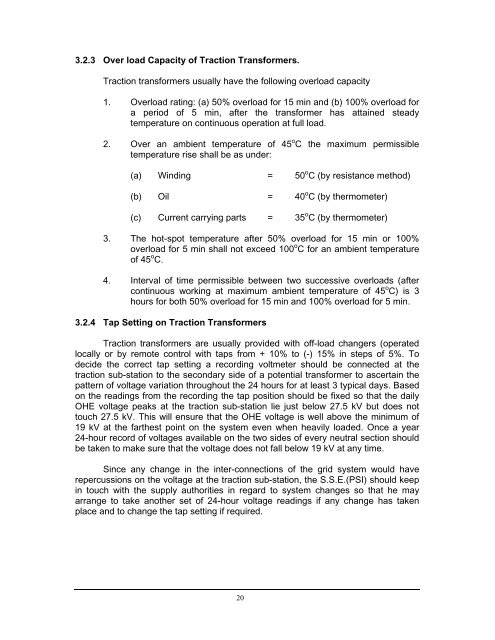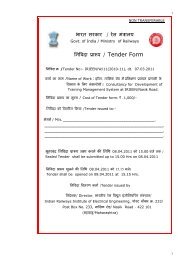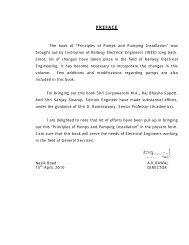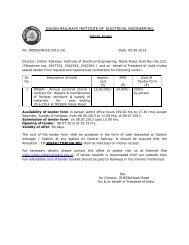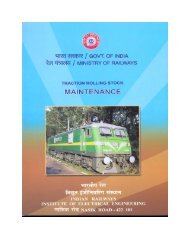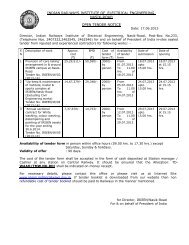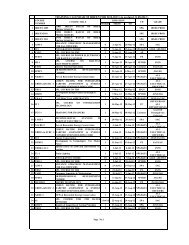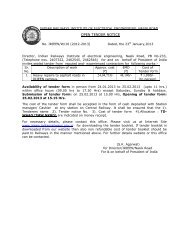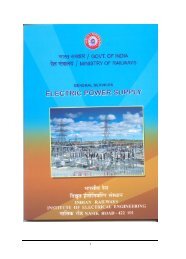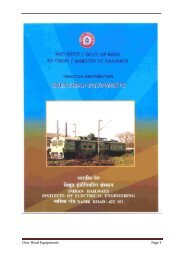remote control equipment - Indian Railways Institute of Electrical ...
remote control equipment - Indian Railways Institute of Electrical ...
remote control equipment - Indian Railways Institute of Electrical ...
You also want an ePaper? Increase the reach of your titles
YUMPU automatically turns print PDFs into web optimized ePapers that Google loves.
3.2.3 Over load Capacity <strong>of</strong> Traction Transformers.<br />
Traction transformers usually have the following overload capacity<br />
1. Overload rating: (a) 50% overload for 15 min and (b) 100% overload for<br />
a period <strong>of</strong> 5 min, after the transformer has attained steady<br />
temperature on continuous operation at full load.<br />
2. Over an ambient temperature <strong>of</strong> 45 o C the maximum permissible<br />
temperature rise shall be as under:<br />
(a) Winding = 50 o C (by resistance method)<br />
(b) Oil = 40 o C (by thermometer)<br />
(c) Current carrying parts = 35 o C (by thermometer)<br />
3. The hot-spot temperature after 50% overload for 15 min or 100%<br />
overload for 5 min shall not exceed 100 o C for an ambient temperature<br />
<strong>of</strong> 45 o C.<br />
4. Interval <strong>of</strong> time permissible between two successive overloads (after<br />
continuous working at maximum ambient temperature <strong>of</strong> 45 o C) is 3<br />
hours for both 50% overload for 15 min and 100% overload for 5 min.<br />
3.2.4 Tap Setting on Traction Transformers<br />
Traction transformers are usually provided with <strong>of</strong>f-load changers (operated<br />
locally or by <strong>remote</strong> <strong>control</strong> with taps from + 10% to (-) 15% in steps <strong>of</strong> 5%. To<br />
decide the correct tap setting a recording voltmeter should be connected at the<br />
traction sub-station to the secondary side <strong>of</strong> a potential transformer to ascertain the<br />
pattern <strong>of</strong> voltage variation throughout the 24 hours for at least 3 typical days. Based<br />
on the readings from the recording the tap position should be fixed so that the daily<br />
OHE voltage peaks at the traction sub-station lie just below 27.5 kV but does not<br />
touch 27.5 kV. This will ensure that the OHE voltage is well above the minimum <strong>of</strong><br />
19 kV at the farthest point on the system even when heavily loaded. Once a year<br />
24-hour record <strong>of</strong> voltages available on the two sides <strong>of</strong> every neutral section should<br />
be taken to make sure that the voltage does not fall below 19 kV at any time.<br />
Since any change in the inter-connections <strong>of</strong> the grid system would have<br />
repercussions on the voltage at the traction sub-station, the S.S.E.(PSI) should keep<br />
in touch with the supply authorities in regard to system changes so that he may<br />
arrange to take another set <strong>of</strong> 24-hour voltage readings if any change has taken<br />
place and to change the tap setting if required.<br />
20


